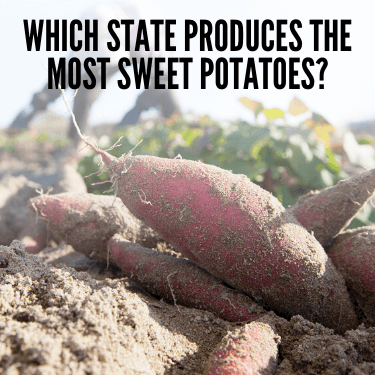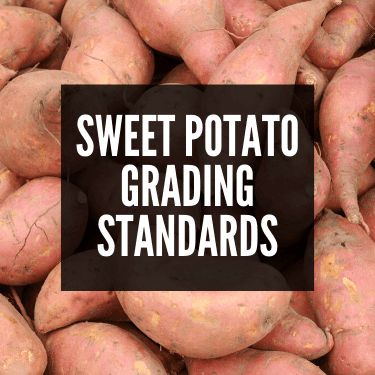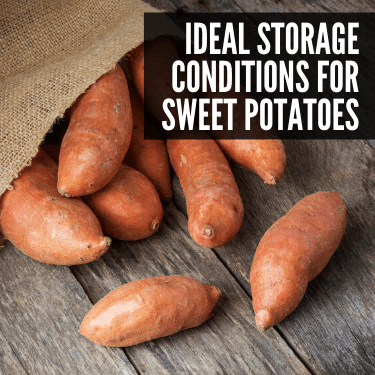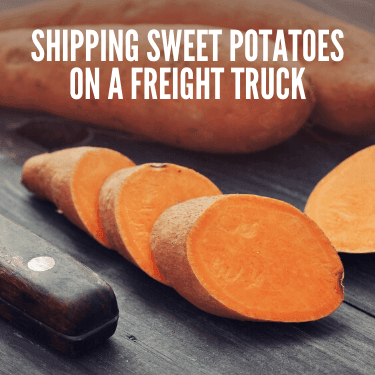Shipping sweet potatoes might seem like an easy task since the hardy roots are durable and relatively impact resistant. However, there’s more that goes into the process that you should know about if you want to start selling this vegetable around the U.S. You can’t simply chuck your produce in a bin and haul them across the States, or you’ll end up with a bunch of sweet potatoes you can’t sell because they deteriorated during the trip. Read on to learn how to best protect your shipment from storage and transport disorders.
Shipping sweet potatoes involves sanitizing and curing them beforehand to increase their shelf life, packaging them correctly to minimize damage, and maintaining a cool (but not cold) and humid environment to prevent moisture loss and hardening during the trip.

North Carolina is by far the biggest producer of sweet potatoes in the U.S. It is responsible for growing 60% of the sweet potatoes that are grown domestically, and is the main reason why the U.S. can boast being the world’s second-largest producer of sweet potatoes—behind only China.
Need freight shipping from North Carolina? See How R+L Global Logistics can help.
In fact, the U.S. produces over 3 billion pounds of sweet potatoes each year, which is valued at more than $700 million! Only 11% of that immense supply is exported to other countries, which leaves the rest to be enjoyed by Americans across the country. Sweet potatoes are also grown in other states too, including Louisiana, California, Mississippi, and Texas, so North Carolina can’t take all the credit.
Shipping sweet potatoes to consumers all across the U.S. requires a lot of careful handling and planning, however. You should start thinking about the best practices to utilize while your sweet potatoes are still in the ground, so you can maximize their shelf life and minimize losses. A good plan ahead of time can significantly decrease losses, and improve the overall quality of your shipment upon delivery.
Are you shipping russet potatoes west? Learn more about freight shipping from Idaho to California.
While sweet potatoes are in the ground, their skin is soft, wet, and delicate. They are easily punctured during harvest, which can introduce bacteria into the vegetable, cause significant moisture loss, and affect the grade and marketability of the harvest. This can be mitigated a bit by cutting the stems a few days before harvesting, which allows the skin to toughen up a bit, though you should still be cautious when unearthing them.
Once the sweet potatoes have been harvested, it is common practice to cure them before getting them ready for shipment. This extends the shelf life of the potatoes, and gives them a sweeter and more full-bodied taste. It also allows the sweet potatoes to heal from any damages incurred from the harvest process. To cure, sweet potatoes are left in an environment of about 85 degrees Fahrenheit and 90 percent relative humidity for several days. After almost a week, the sweet potatoes are then cooled and processed for shipping.
Most large scale growers utilize a certain amount of automation to manage the huge quantity of sweet potatoes they have to process. Sweet potatoes are dumped via giant rotating machine arms into large vats of water to wash them off and remove debris, then rollers spaced 1.5 inches apart sort out any that are too small. Conveyor belts then move the sweet potatoes into another bath, this time treated with fungicides to kill and prevent fungus growth in shipping and storage.
Failure to handle this process correctly could result in significant losses during transport. As with any produce, you should utilize the best-proven practices to keep it fresh and healthy during the trip. Without the proper treatments and handling at this stage, most of your sweet potatoes wouldn’t make it to their destination intact.
During this process, the sweet potatoes are also graded by workers on either side of the conveyor belt—often twice, to ensure the original grade is double-checked.

The grade of a sweet potato harvest is not something consumers think about—or are probably even aware of—but it is tremendously important to producers. A sweet potato’s grade determines what it can be used for, and how much profit a farmer can gain from it. In addition to that, the sweet potato’s grade can give some guidance on how that individual batch should be marketed, and to whom.
No matter what grade a batch of sweet potatoes is, there’s one thing they all have in common: none of the grades allow for any pests or diseases to have affected the batch. This includes internal breakdown of any type, different types of rot and decay, mold, pox, wireworms, weevils, and other insects. Damages from other roots and sprouts, such as bruises and scars, are also not allowed.
You should ensure a thorough inspection process is conducted to detect signs of any of those problems. They might not be obvious at first, but if left unchecked could wreak havoc on the batch in the back of a freight truck.
Once you have determined the grade of a particular batch of sweet potatoes, then it is time to pack them up to prepare them for shipping.
When packaging sweet potatoes, you have many options. All packages must contain, protect, and identify the sweet potatoes, but apart from those requirements, there aren’t really any other restrictions for what you can and cannot use. The most common option is by packaging the sweet potatoes in a 40-pound carton, but as of recent, smaller packages are starting to become more widespread.
To figure out how you should package your sweet potatoes, you should consider what you want your customer’s buying experience to be like. If you want consumers to be able to simply pick up a small container and check out with it, then you could use mesh bags, shrink wrap, small cartons, clamshell packaging, plastic bags, or boxes. As long as the sweet potatoes don’t have a lot of space to shift around in the container, they should only sustain minimal damages.
Alternatively, if you want consumers to be able to pick out sweet potatoes to weigh and purchase as many as they want, then shipping in large cartons is going to be fine. Large cartons stack well and fit neatly on pallets and in the back of a freight truck. As long as the sweet potatoes are packed correctly, and the cartons are designed to withstand the weight of being stacked on, this can be a great option for moving bulk shipments.
If you’re moving a bulk shipment of consumer packaged sweet potatoes, then you should pack the primary packages into a larger tote, or find some way to palletize the smaller containers. Make sure the primary and secondary containers are both going to hold up in high-humidity environments, since things like certain wood and cardboard lose their strength as they get damp. Being able to move many containers at once on a sturdy pallet can save you a lot of time and labor costs.
No matter what kind of package you decide to utilize for your shipment, you will still need to comply with the applicable government regulations for labeling fresh produce. That includes identifying the product, wax labeling, health and organic claims, and company and brand information.

Sweet potatoes are not necessarily delicate, but things can still go terribly wrong if you aren’t monitoring the conditions they’re being kept in. Like all produce, any facility, container, and truck that will be in contact with the sweet potatoes must be kept as clean and sanitary as possible. Failure to keep things clean could result in bacteria being introduced into the batch, which could cause a host of diseases and fungi that would ruin the batch.
In addition to that, you should carefully monitor the temperature and humidity during shipping. If those conditions aren’t kept correct and consistent throughout the sweet potatoes’ journey, then the batch could seriously decrease in quality. To keep them fresh, you should ensure the temperature stays at around 55-60 degrees Fahrenheit throughout the entire trip. You should also keep the relative humidity as high as possible without resulting in water forming on the sweet potatoes themselves. The ideal relative humidity range is between 85 and 90 percent. Decent air flow is also an important factor for long-term storage.
Failure to maintain the proper conditions would cause the sweet potatoes to rapidly deteriorate. With so much on the line, you should work with a carrier that you know you can trust to keep your sweet potatoes fresh during shipment. At R+L Global Logistics, we know how important it is to maintain the exact conditions specified, and we take pride in the cleanliness and timeliness of our carrier partners. If you want the peace of mind of working with a proven reliable logistics company, then we’re the right choice for you!
Sweet Potatoes are extremely freeze-sensitive vegetables, making it imperative that you control the temperature during shipping—and throughout the supply chain. When sweet potatoes are allowed to get too cold, that changes the structure of the cells inside them. The orange flesh of the vegetable will pale and turn hard, and no amount of cooking will make it soft and palatable again.
However, letting sweet potatoes get too warm for too long will also have negative consequences. Although they can (and should) be allowed to get up to 80 degrees for several days after harvest in order to cure properly, they should be cooled down to 55-60 degrees Fahrenheit immediately afterward. If they stay too warm for too long, the heat will cause the vegetables to start drying out, the skin will start to shrivel, and tiny holes will form inside its orange flesh.
To keep it within the safe range, around 55-60 degrees Fahrenheit, you’ll need to consider different options for regulating temperature. One option is to pack it in an insulated container, so fluctuating outside temperatures do not affect the air around the sweet potatoes. However, this isn’t a failsafe. If your shipment needs to travel a longer distance over several days, especially in particularly extreme temperatures, then a simple insulated container just isn’t going to cut it. Thankfully, you have other options with truckload shipping.
Sweet potatoes aren't the only thing on your Thanksgiving table that requires careful shipping. Learn more about cranberry transportation.

Truckload shipping is the most common choice for shipping sweet potatoes, and with good reason. It is an affordable option, it can get your shipment delivered almost anywhere in the U.S. in a matter of days, and it is incredibly versatile. In most cases, a regular freight truck will be all you need to move your shipment of sweet potatoes across the U.S. However, if your produce will be moving through particularly extreme or unpredictable temperatures, then you may want to invest a little extra in getting a temperature controlled truck to move your freight.
Refrigerated shipping is a fantastic option for several reasons. For one thing, by utilizing refrigeration and careful monitoring, you can be sure that the inside of the trailer will be kept at exactly 55 degrees Fahrenheit for the entire trip. If your shipment has a long way to travel, the price increase on this type of shipping could be worth the peace of mind you’d get from knowing your sweet potatoes will get to their destination at the highest quality.
Another option that you could utilize when shipping any kind of perishable commodity is what’s known as “expedited freight services.” By utilizing this type of shipping, your shipment would be given priority over others, so it will get on the road a lot sooner. This also means that your shipment would be delivered as quickly as possible, with the shortest route and no unnecessary stops. Usually, that means it’s delivered same-day, overnight, or next-day. And, when you’re dealing with perishable commodities, every hour makes a difference.
If you need help shipping sweet potatoes, you can count on R+L Global Logistics to provide the best service in the industry. Our team of logistics professionals and experienced partner carriers can assist with the movement of any type of freight, whether it’s produce, seafood, or even hazardous materials. With our best-in-class customer service and 99.5% on-time delivery record, your reputation speaks for itself! By working with us, you not only have access to a range of customizable, flexible shipping options, but you can also benefit from our:
We can ship your sweet potatoes anywhere in the U.S., regardless of whether it’s shipping from North Carolina to Texas or elsewhere. You can count on us to get your shipment delivered anywhere on-time, intact, and with complete visibility. As a family owned company, we extend our family values to each of our customers, offering unparalleled customer service, customized freight solutions, and 24/7 support.
If you’re ready to start shipping sweet potatoes, or anything else, give us a call at (866) 353-7178 to request a Freight Quote today.
R+L Global Logistics
315 NE 14th St., Ocala, FL 34470